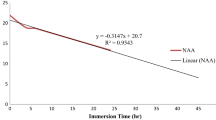Synopsis
An aqueous solution of mercurous nitrate reacts with bone and tissue calcified sites with the formation of brown to black amorphous masses and feathery crystals, the last resembling the crystals formed from the action of an aqueous solution of mercurous nitrate on calcium orthophosphate. Calcium oxalate reacts with this mercurous nitrate solution to form brown to black deposits on the surface of the oxalate particles; this suggests an adsorption phenomenon. The brown deposits are blackened by ammonium hydroxide, gold chloride, and many sulphur-containing compounds.
Similar content being viewed by others
References
Barber, H. H. &Taylor, T. I. (1953).Semimicro qualitative analysis, pp. 111–35. New York: Harper and Brothers.
Cox, A. J. Quoted by J. W. Mellor (1929).A comprehensive treatise of inorganic and theoretical chemistry. Vol. 4, p. 989. London, New York: Longmans, Green.
Chamot, E. M. &Mason, C. W. (1931).Handbook of chemical microscopy. Vol. 11, p. 137. New York: Wiley.
Denham, H. G. &Fife, C. V. (1933). The ternary system mercurous oxide-nitrogen pentoxide-water.J. chem. Soc. 11, 1416–19.
Eisenstein, R., Werner, M., Papajiannis, S., Konetzki, W &Laing, I. (1961). Chloranilic acid as a histochemical reagent for calcium.J. Histochem. Cytochem. 9, 154–6.
Feigl, F. (1958).Spot tests in inorganic analysis, 5th Ed., pp. 362–3, New York: Elsevier.
Lillie, R. D. (1965).Histopathologic technic and practical histochemistry, 3rd Ed. Blakeston Division. New York: McGraw Hill.
Pizzolato, P. (1964). Histochemical recognition of calcium oxalate.J. Histochem. Cytochem. 12, 333–6.
Pizzolato, P. &Lillie, R. D. (1968). The impregnation of bone and pathologic calcification by metal salts and their recognition by unoxidized hematoxylin.Histochemie 16, 333–8.
Pizzolato, P. &Mccrory, P. (1962). Light influence on von Kossa's silver nitrate calcium reaction in the myocardium.J. Histochem. Cytochem. 10, 102.
Pizzolato, P. &Pizzolato, J. M. (1966). Histochemical recognition of calcium oxalate. II. Its differentiation from other calcium salts found in animal tissues.Am. J. Med. Technol. 32, 247–50.
Vonkossa, J. (1901). Über die im Organismus künstlich Verkalkungen.Beitr. Path. Anat. 29, 163–202.
Author information
Authors and Affiliations
Rights and permissions
About this article
Cite this article
Pizzolato, P. Mercurous nitrate as a histochemical reagent for calcium phosphate in bone and pathological calcification and for calcium oxalate. Histochem J 3, 463–469 (1971). https://doi.org/10.1007/BF01014785
Received:
Issue Date:
DOI: https://doi.org/10.1007/BF01014785




